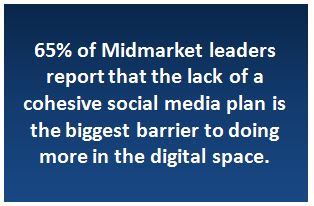The business world wants to go digital … and fast. But they just can’t figure out social media.
That’s one of the conclusions of a landmark study released today by IBM called “The Customer-activated Enterprise,” — a result of face-to-face conversations with more than 4,000 C-suite executives worldwide. Because IBM is a client, I was privileged to get a preview of this research to share with the readers of {grow}.
This study included a variety of businesses from “Midmarket” SMB’s to global giants. The study paints a picture of executives determined to drive change in every facet of the organization through digital initiatives. In fact, they now see technology as the dominant driver of their businesses.
The research discovered three major strategic shifts enabled by technology:
The customer-activated company
 The “most radical” of the three shifts is an overwhelming recognition of the social web’s unleashing of customer influence and its impact on not just new product development, but collaborative approaches on business strategy.
The “most radical” of the three shifts is an overwhelming recognition of the social web’s unleashing of customer influence and its impact on not just new product development, but collaborative approaches on business strategy.
“The cultural and organizational implications are huge,” the report states. “Relationships must be fully reciprocal and once that relationship is established, companies of all sizes need to be prepared to act based on the influence of the customer. In this way, organizations are shifting from being merely customer-centric to becoming customer-activated.”
As a result, technology must have a role in gathering and assessing customer input in key business decisions. This also has some important organizational implications as businesses work to overcome customer’s mistrust of being “targeted” and C-suite leaders being asked to give up autonomy and control.
An integrated digital organization is ideal, but social ROI is a stumbling block
The emergence of social, mobile and digital networks has played a major part in democratizing the relationship between organizations and their customers, the study reports.
Businesses are stepping up activities to digitize beyond just marketing, including supply chain, analytics tools and workforce skills required for collaboration. The majority of CIOs surveyed say they aim to digitize their front offices within the next few years to sync with customers more effectively. The use of mobile devices plays a key role in doing that.
 Despite this focus, less than half of Midmarket organizations have a fully integrated physical and digital strategy. Their biggest hurdle isn’t technology or security. Their challenge is to understand how social media fits into the mix, and its return on investment. To achieve full value, social media, as well as social business, needs to inspire entirely new ways of working, learning, and orchestrating processes across the organization and beyond.
Despite this focus, less than half of Midmarket organizations have a fully integrated physical and digital strategy. Their biggest hurdle isn’t technology or security. Their challenge is to understand how social media fits into the mix, and its return on investment. To achieve full value, social media, as well as social business, needs to inspire entirely new ways of working, learning, and orchestrating processes across the organization and beyond.
Craft engaging customer experiences
Companies of every size told IBM that a re-balancing is occurring from spending on “IT systems” to “creating customer experiences.”
Despite this strong trend, the ideal of a customer-centered “social enterprise” is still far from reality.
“Surprisingly, organizations of all sizes are lagging in social initiatives,” the study noted. “A social approach starts with giving customers opportunities to air their views. The most advanced enterprises go even further. They analyze data to understand people holistically – what’s happening at the moment, what their core values are. These insights provide the foundation for a customer experience tailored to the individual.” But the path to accomplish this is not always clear.
Technology is the easy part
On a personal level, my own experience certainly validates the trends IBM has identified and explained. I interact with hundreds of executives every year who are putting tremendous resources toward enabling a digital enterprise … but with mixed results.
 Here is a firm conclusion I have made along the way. Yes, technology absolutely can make changes like a customer-activated company possible. But making it a reality requires not just technological change, but dramatic organizational change. We can make technology do anything we want. That is not the case with people.
Here is a firm conclusion I have made along the way. Yes, technology absolutely can make changes like a customer-activated company possible. But making it a reality requires not just technological change, but dramatic organizational change. We can make technology do anything we want. That is not the case with people.
Technology promises radical change. Guess what? People hate radical change.
As this study states, the intent to make these organizational changes is ubiquitous, but I think measurable success will be far more rare because it will take extraordinary, tenacious, and patient leadership to forge entrenched company cultures into something radically more open, more collaborative, and more responsive.
That’s my take any way. What are you seeing out there?
Illustration courtesy BigStock.com
This post was written as part of the IBM for Midsize Business program, which provides midsize businesses with the tools, expertise and solutions they need to become engines of a smarter planet. I’ve been compensated to contribute to this program, but the opinions expressed in this post are my own and don’t necessarily represent IBM’s positions, strategies or opinions





